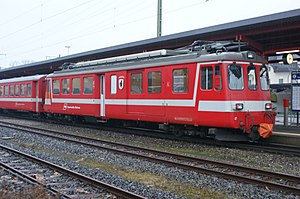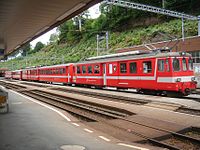AB BDe 4/4
| AB BDe 4/4 | |
|---|---|
|
BDe 4/4 47 in 2009 in Gossau SG
|
|
| Numbering: | 46-47 |
| Manufacturer: | FFA , SIG , MFO |
| Year of construction (s): | 1968 |
| Axis formula : | B 0 'B 0 ' |
| Gauge : | 1000 mm ( meter gauge ) |
| Length over buffers: | 18 900 mm |
| Total wheelbase: | 15 450 mm |
| Service mass: | 37.8 t |
| Top speed: | 65 km / h later 75 km / h |
| Hourly output : | 559 kW (760 PS ) at 32 km / h |
| Starting tractive effort: | 106 kN |
| Driving wheel diameter: | 900 mm |
| Power system : | 1500 V = |
| Number of traction motors: | 4th |
| Transmission ratio: | 1: 7.5 |
| Seats: | 32 |
| Classes : | 2nd Class |
| Loading area: | 11 m² |
The BDe 4/4 are two meter-gauge railcars with second-class and luggage compartments of the former Appenzeller Bahn (AB). In 1988 they came to Appenzeller Bahnen (AB) through the merger of the Appenzeller Bahn with the SGA .
history
The investment program made possible by the 1966 revised Railway Act enabled the Appenzeller Bahn to renew the rolling stock for 1.24 million francs. In 1968, the new BDe 4/4 No. 46 and 47 multiple units, an EW-1 B 26 intermediate car and a matching ABt 61 control car could be put into operation. A remote control enables the formation of shuttle trains . However, it does not go together with the BDZt 60 and DZt 65 control cars delivered in 1949. The BDe 4/4 were built by Flug- und Fahrzeugwerke Altenrhein (FFA). The electrical part comes from Maschinenfabrik Oerlikon (MFO) and the bogies from Schweizerische Industrie-Gesellschaft (SIG).
technology
The end walls of the BDe 4/4 are inclined and slightly rounded , as with the RBe 4/4 of the SBB and the BDe 4/4 of various normal-gauge private railways . The latter also corresponds to the concept with a second-class and a luggage compartment. The first-class compartment is housed in the control car because of the somewhat less comfort in the railcar. The vehicles originally had a red / cream paint job.
Because of the direct current system of the Appenzeller Bahn, the electrical equipment differs fundamentally from the standard gauge railcars. The hopping control is designed as an economy circuit. With just 10 shooters, 29 driving and 13 braking levels were achieved. Despite the high output of 559 kW , peg bearing drives were installed.
In 1997 and 1998 the vehicles were modernized. The driver's cab doors were welded into the fronts and new headlights were installed, the central buffer coupling and the roof rods were replaced by + GF + couplings and heating cable connectors and the seating was renewed. The red repainting was based on the model of the BDe 4/4 II 41–45.
business

Because the Appenzeller Bahn ran both car classes on all trains and only one car with a first-class compartment was available for the two railcars - namely the associated control car, certain operational problems arose at first. In 1972 the FFA delivered a second ABt 62 control car.
After a landslide on July 17, 2004, a train with the ABt 62 control car derailed near Herisau and fell down the embankment. The red painted control car was then broken off.
Name and coat of arms
The railcars have had the following names and coats of arms since 1986:
| No. | Surname | coat of arms |
|---|---|---|
| 46 | Waldstatt |
|
| 47 | Urnaesch |
|
Associated control and intermediate cars
From 1964 to 1973, the Appenzeller Bahn purchased six second-class EW I cars , all of which are equipped with multiple control lines and are therefore suitable as intermediate cars in commuter trains with the BDe 4/4.
| Type and number | Manufacturer | Construction (renovation) |
length | bicycle stand |
Dimensions | V max | Places | comment | |
|---|---|---|---|---|---|---|---|---|---|
| 1st class | 2nd class | ||||||||
| ABt 146 (ex 61) | FFA / SIG / MFO | 1968 (1998) | 19.00 m | 15.30 m | 18.5 t | 75 km / h | 12 | 39 | Toilets, canceled in 2015 |
| ABt 147 (ex 62) | 1968 (199?) | Toilets, discarded in 2004 | |||||||
| B 241 (ex 231, ex 23) | FFA / SIG | 1964 (87/2004) | 18.52 m | 14.63 m | 18.0 t | - | 54 | since 2004 without toilets, but with translating windows | |
| B 242 (ex 233, ex 25) | 1966 (87/2004) | ||||||||
| B 243 (ex 247, ex 27) | 1973 (96/2007) | Toilets, with translating windows since 2007 | |||||||
| B 244 (ex 232, ex 24) | 1964 (1987) | 17.5 t | 64 | since 2004 without toilets | |||||
| B 245 (ex 248, ex 22) | 1964 (1996) | 56 | Toilets | ||||||
| B 246 (ex 26) | 1966 (97/2008) | 18.0 t | 55 | Toilets, with translating windows since 2008 | |||||
Since the delivery of the "Walzer" ABe 4/12 trains in 2018, the EW I cars are no longer required.
literature
- Peter Willen: Locomotives in Switzerland 2 - narrow-gauge traction vehicles. Orell Füssli Verlag, Zurich, 1971, p. 197
- Appenzeller Bahnen AB. On the website of the Swiss Rolling Stock Directory Association. As of January 1, 2010 with changes until 2012 (PDF; 0.1 MB)
- Hans Rudi Lüthy-Pavan: The Appenzell Railway Part 5. Line Gossau-Herisau-Urnäsch-Appenzell- (Wasserauen). On: "The narrow track". Reports on narrow-gauge, rack-and-pinion and local railways. July 2008
Individual evidence
- ^ Mathias Rellstab: AB train derailed after landslide. In: Swiss Railway Review . No. 10/2004. Minirex, ISSN 1022-7113 , p. 432.
- ^ Mathias Rellstab: The new fleet of the Appenzeller Bahnen is rolling. In: Swiss Railway Review. No. 5/2018. Pp. 275-278.





